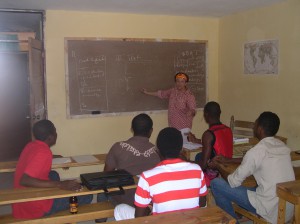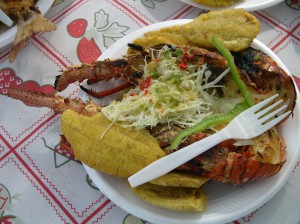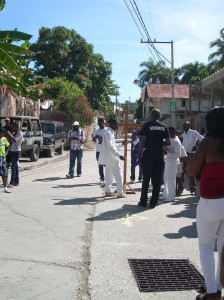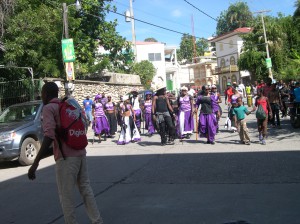Part II Last day in Jacmel, November 11, 2014
OK, I need to back up a few days to really talk about my last day. On Sunday, I had spent time with Max teaching the group how to construct a test for competence. We spent almost 3 hours working on this, and again, the guys attention waned, and they nodded sleepily. Hard to do on a rough wooden bench!
Later in the day, I spent time interviewing each of Max’s Intermediate English students so they could have some time to talk to an English speaker. One student was especially interesting. 
The student taught French in a local high school. I asked him about his teaching credentials and where he went to school to become certified. He told me that he went to law school, and so he knew French. I then asked him where he learned to teach Friench. He again told me that he went to law school. The same answer. There was something here that I was not understanding. It took me a minute to realize that because he went to law school and graduated he was qualified because in Haiti the law court and business is conducted in French. That made him qualified to teach French.
Haiti relies upon the subject area content and not any teaching credentials. Sometimes, not even that. If a persona goes to university and takes a series of courses in biology, for example, the person can apply for a job at the high school to teach Math or any other subject, if the person demonstrates schooling beyond the high school diploma.
I have waited almost two weeks to write this final entry because learning Haiti this time was bittersweet. On the Monday of the final week, I spent the day in my hotel. The government had said that it was going to charge the “taxi”drivers almost 6,000.00 goudres ( I think) for insurance to operate their motorcycles. The taxi drivers protested this enormous increase by stopping all taxi transportation, burning tires in the middle of the paved streets, and taking some violent action against those taxi drivers who continued to work.
Pastor Caleb advised me to stay out of the situation entirely, since the roads were blocked off, and there was no safe way for me to get to FLI on Monday. So, I stayed at the hotel, sat outside for a while, read, and wrote in my journal and notes.
On Tuesday, my last day, the guys came to the hotel for our final focus group meeting, and the final workshop on teaching ESL. It went well, but Yvenord fell asleep while the DVD was playing; Max had to leave early. His girlfriend’s father had died that morning, and he needed to take his little daughter to the doctor for her checkup. So much going on all the time in the lives of these young men. Without spending so much time with them, I would never have come to know them, at least a little part of them.
That night—we went out to dinner. I had never eaten in a place other than the hotel in the times I have been to Haiti. So, I was excited about this place. I should have known…..
The place was called “ Chandiliere” and was set back from the main street through an open alley, the kitchen was off to the left side, and the tables were spread out over quite a large area. At the back of the restaurant, there was a very large flat screen TV blaring the broadcast of a soccer awards show in Madrid, I think. Anyway, the language was Spanish. The guys ordered for me— something not hot and spicey. Three of us had the Haitian beer—Prestige—and two others had some heavy malt flavored beverage. As for conversation— well, with the soccer game and awards, the guys began arguing over their favorite team, and who would win. This was all exchanged in Kreyole, but men talking about sports needs little translation, in any language. I laughed and just waited for them to change the topic. Most of the time before dinner was a conversation among them about soccer. Then food arrived.
It was three chicken legs, a plate full of fried plantains, and some beans and rice! Ah, I was expecting the beans and rice I ate at the hotel each day, but this was very brown in color, and not because it was brown rice. It was rice cooked with some kind of mushroom or spice that gave it a very woody flavor, not really a pleasant taste to me, but I ate it anyway. I gave one of my chicken legs to Yvenord to finish— they are always hungry and this dinner was on me! I wanted to take them out just once to share some cheer and casual camaraderie, but about this time Yvenord asked me,” How was my dinner?” I said,” Well, I don’t know how it was, but it is just fine. Which verb tense did you really mean?”
For some reason, they all just howled with laughter— not at Vyenord, but at the real practice of English when it means something ! English in practice with an English speaker…. Laughter just caused more laughter, since we all understood some part of the joke about speaking English correctly… I know, you had to be there, but this was really the point at which the 6 of us could put down our various roles and just be a group out to dinner and having fun. Finally, we were having fun—not just an awkward gathering anymore. The tensions eased….
Then, they order 6 mango juice classes at the end of the meal. Hmmmm. I didn’t know if this was a tradition or not.
Well, I had to pay the bill, and I brought out my credit card… They didn’t take credit cards; they only took cash. I didn’t have enough to cover the bill, so… while Esdra, Richardson and Yvenord stayed, Jeames took me on his motorbike to get some case at the ATM. Well…….
I didn’t have my debit card, and the machine would not take my credit card, so Jeames had to take me all the way back to the hotel to get my cash, and then drive back to restaurant to pay the bill! I felt terrible— Another American blunder, assuming that I could just use the plastic form of payment— and not the real thing.
Anyway, I stayed at the hotel, since it would cost more goudres to bring me back to the restaurant and return me again to the hotel. I was leaving at 4:30 for the plane.
At 4:30 a.m., the van arrived to take me to Port au Prince. It was a quiet ride, which heralded the whole return trip to Philadelphia. I was home at 6:30 that night, and far away from Haiti. Traveling long distances in day and traveling between very different cultures is jarring. My habits are in one world while my physical body is in another, at least for a while.
As I left PAP, I knew that I wanted March and spring vacation to come quickly! In an email from Max wondering if I arrived safely home, he told me that he had expected out dinner to be very boring, but that he had really enjoyed himself that evening.
Here is one final shot of a hillside in Haiti. Remember I said “bittersweet.”















